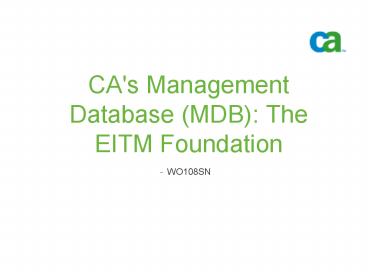CA's Management Database (MDB): The EITM Foundation - PowerPoint PPT Presentation
1 / 31
Title:
CA's Management Database (MDB): The EITM Foundation
Description:
WO108SN Abstract An integrated Management Database (MDB) is an important foundation for achieving effective Enterprise IT Management, this session describes what CA ... – PowerPoint PPT presentation
Number of Views:98
Avg rating:3.0/5.0
Title: CA's Management Database (MDB): The EITM Foundation
1
CA's Management Database (MDB) The EITM
Foundation
- WO108SN
2
Abstract
- An integrated Management Database (MDB) is an
important foundation for achieving effective
Enterprise IT Management, this session describes
what CAs MDB is and the value it provides.
3
CAs Vision
Enterprise IT Management (EITM) is CAs vision
for how to unify and simplify the management of
enterprise-wide IT
Manage and Secure
4
EITM Unify and Simplify It All
Business Service Optimization
Security Management
Storage Management
Enterprise Systems Management
IT Processes Best Practices
Manage and Secure
5
EITM - Manage Secure It All
Business Service Optimization
Security Management
Storage Management
Enterprise Systems Management
IT Processes Best Practices
Manage and Secure
6
Agenda
- All about the MDB
- Deployment topics
- Support for standards
7
The Problem In General
- Too many databases
- Complex to manage
- Require lots of labor
- Capital under-utilized
- Vulnerable infrastructure
8
The Problem Disparate Management Data
- Too many versions of the truth
- If you dont know what you have, how can it be
managed
9
Benefits of CAs Solutions
- CA solutions provide comprehensive, integrated,
modular and real-time solutions to - Manage risk
- Improve service
- Control costs
- Align IT investments with business needs
10
Built on CAs Integration Platform
- The CA Integration Platform is the foundation
made up of a set of shared services providing
tight integration - Consistent user experience
- Integrated data
- Integrated processes and workflows
- Common policy
- The CA Integration Platform also contains a rich
set of management and security services that
deliver consistent definition and behavior
11
CAs EITM Integration Platform
12
MDB A Management Service
- Full spectrum of management data
- Integration at the data level
- Flexible deployment options
- Management for high performance
- Support for open standards and best practices
13
The Value of Data Integration
14
Full Spectrum of Management Data
- Assets and inventory
- Business processes
- Events
- Organization/people
- Policy/rules
- Schedules/workflows
- Service
- Software configurations
- Internal management data
- Management metadata
- Product settings
15
Increased Visibility
- Requires single source of IT management data
- Speeds decision making
- Enables automation
16
Management Intelligence
17
Eliminates Redundancy
- Reduces maintenance and administration
- Integrates at the source
- Results in fewer data errors
18
Extensible Definitions
- Customers and third parties can extend schema
- Allows integration beyond CA products
- Enables sharing of data
- Removes redundancy and keeps data synchronized
- Eases administration
19
MDB Data Access Options
- Data transformer
- Moves data between MDB and other systems
- Basis for hub and spoke deployment option
- Supports XML as data source or target
- Example UAPM import of SMS data
- Formal Object Interfaces
- Delivered with some products
- Enable integration at a higher level
- Ex NSM Worldview API, ServiceAware for Service
Desk - Custom data integration
- Programmatic access to read and write the MDB
directly - Native SQL, ODBC, JDBC available
- Reporting and Data Mining
- Data stored in a relational database management
system
20
Deployment Options
21
A Single MDB
- Applications share a MDB
- More applications provide richer data
- Little integration required
22
Multiple MDBs
- Uses more than one MDB
- Integration may be required
- Product specific
- Distributed query
- Replication
23
External Product Integration
- Integrates data from external and 3rd party
sources - Provides data from the MDB for use in other
applications/products
24
Relational Databases Supported
- Ingres r3
- SQL Server 2000
- SQL Server 2005
- Oracle 10g Release 2
25
Database Server Requirements
- Enterprise utilization and access
- Disaster recovery planning required
- Cluster support for high performance
- 64-bit enabled
26
Security and Availability
- Single schema eases security
- RDBMS integrates with OS security
- Online or offline backup
- BrightStor ARCserve
27
Standards
28
MDB and ITIL
- CA products used to implement ITIL processes
store data in the MDB
29
MDB versus CMDB
- The MDB stores information about assets and
configuration items such as incidents, problem,
change orders, capacity, finance, current state
and a great deal more - Can be used to support CMDB requirements
- Does not provide federated CMDB capabilities
- In general, is not a CMDB
30
The MDB and DMTF/CIM
- CA has belonged to DMTF since inception
- Network and system management portions of MDB
schema were designed based on early releases of
CIM - MDB CIM are not the same thing
- MDB is a complete definition of the management
information required by CA products. - MDB is a relational database
- Common Information Model (CIM) provides a vendor
independent abstraction layer defined as an
object model - CIM interfaces to the MDB are being considered
for the future
31
Summary
- The MDB Management Service helps to
- Manage risk
- Ensure security and data availability
- Help meet corporate compliance / governance
requirements. - Support open standards and best practices
- Improve service
- Manage availability and performance of the
infrastructure - Real time data, not warehoused
- Flexible deployment options
- Control costs
- Optimizing IT assets due to improved visibility
to data - Easy to deploy
- Less management required
- Align IT investments with business needs
- Make informed management decisions
- Determine real cost of IT
- Ensure effective utilization of staff and
resources
32
Questions Answers






![[Study Tips] APMG International Change Management Certification Exam PowerPoint PPT Presentation](https://s3.amazonaws.com/images.powershow.com/9661122.th0.jpg?_=20210915051)























